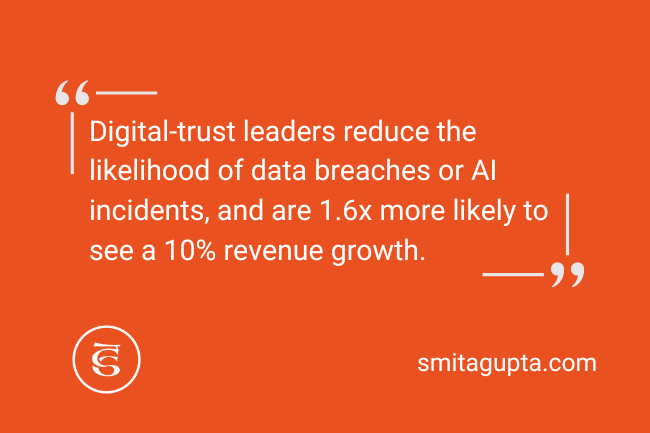As part of brand positioning and value creation exercise, I always ask my clients to think about trust. Trust is so important for building a solid brand reputation and consistent customer conversion. One of the most important factors for building trust, is transparency about a business’ use of data.
The majority of customers want to understand a business’ data privacy and AI policies, and nearly half will consider another provider when policies are not clear or accessible.
Despite thinking companies in general want to profit from their data, 70% of customers have trust in the businesses they buy from.
With 67% of execs admitting to a data breach in the last three years, is this trust misplaced?
Businesses can be doing more to live up to their customers’ expectations. McKinsey examined digital-trust leaders and how they set themselves apart.
They set specific trust-building goals to increase your brand’s standing with customers.They prioritise value-driving goals like strengthening customer relationships.They mitigate a number of risks such as cybersecurity, data retention and AI model difficulties. As a result, digital-trust leaders reduce the likelihood of data breaches or AI incidents, and are 1.6x more likely to see a 10% revenue growth.
The more transparent businesses are with their data usage, the better they perform.
Are you prioritising transparency in your data strategy?

Using data within your business
Are you collecting a large pool of data, but see it go to waste because data isn’t converted into actionable insights?
It can be difficult to decipher data when there is so much, so I’ve put together these steps to keep your data useful:
Look for the right data
It might sound obvious, but it saves me a lot of time to look for the data that will support my business objectives. This way, I keep away from distracting stats and focus on a particular pain point.
Collect and process the data
The data is likely housed in different platforms and perhaps in non-compatible formats. Investing in data-processing software helps to remove any barriers to transforming your data into useful insights.
Analyse the data visually
Using endless spreadsheets is a thing of the past. Once a dashboard has been set up to pull all the necessary data, I find it far easier to examine and draw conclusions from the data presented. Drawing insights starts with understanding what is in front of you, which is encouraged by visual analytics.
Draw your conclusions
With the data in one place and presented for analysis, it is time to create actions. As industry experts armed with the relevant data, executives can make strategic decisions that are now more likely to generate suggested outcomes.
Businesses often recognise the value of data but aren’t using it to its full potential. By prioritising insights, the data becomes more manageable and actionable for your business.
Get in touch to explore how to better manage your data and insights.
